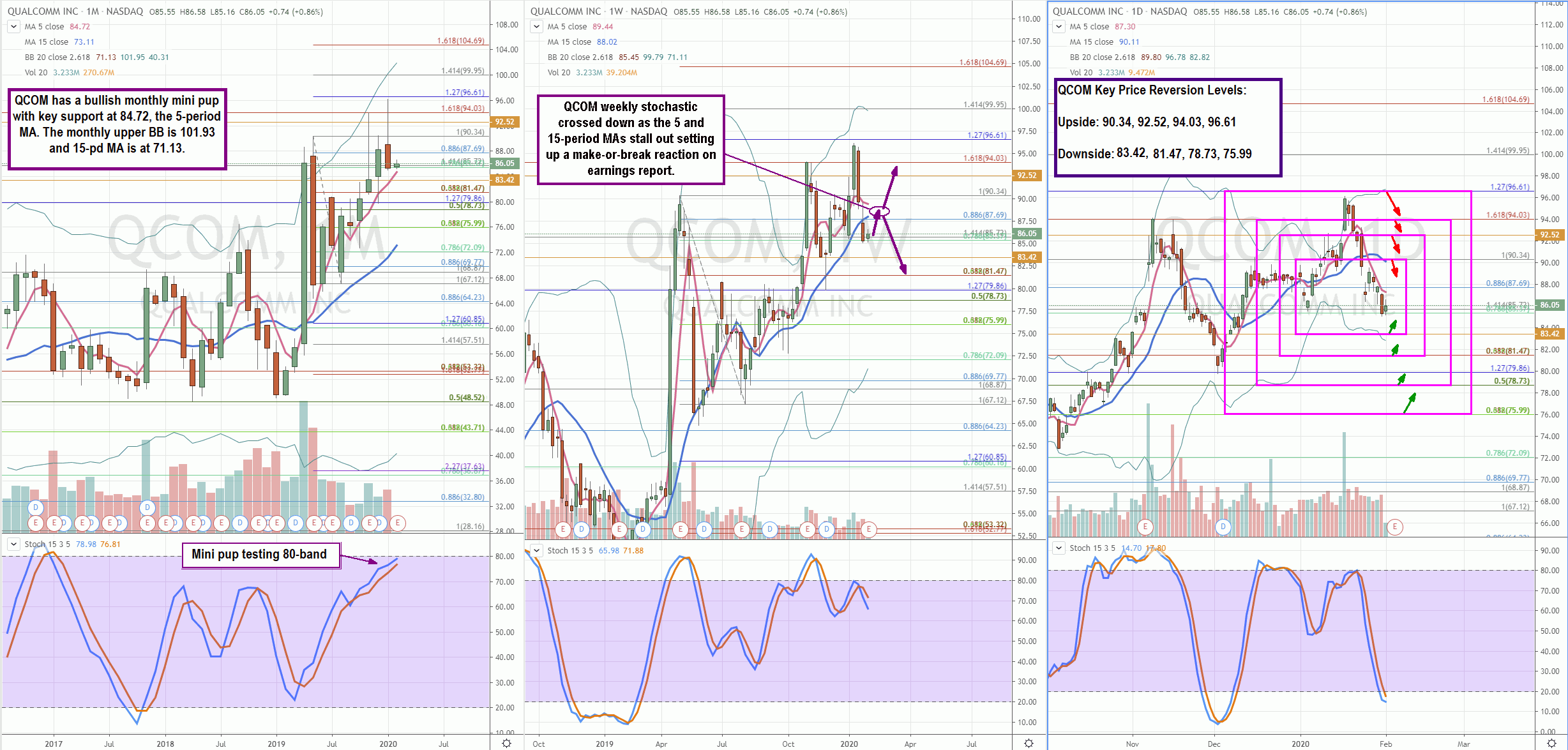Mobile chipmaker
Qualcomm NASDAQ: QCOM reports Q4 2019 earnings after the close on Wednesday, Feb. 5, 2020. Analysts expectations are for $0.86-earnings per share (EPS) on revenues of $48.53 billion. Investors will want visibility on the impact of China trade and supply chain disruption stemming from the Coronavirus. QCOM is a key benefactor from the global rollout of 5G networks inevitably triggering mobile device upgrade cycles especially after the finalizing licensing settlements with Apple, Inc.
NASAQ: AAPL paving the way for future integration into their devices. Consumers may be delaying smartphone upgrades until deeper 5G integration which could pose short-term weakness in favor of longer-term upside. Its in the hands of management and how they paint the narrative moving forward.
Macro Context and Influences
The S&P 500 ETF NYSEARCA: SPY is our macro market indicator. Market sentiment remains relatively negative from the triple whammy of Coronavirus contagion, interest rate inversion and global manufacturing slowdown. On the flipside, central bank intervention has helped put in a very near-term bottom. If markets can stabilize and resume a risk-on stance, then QCOM may be setting up for new highs. However, pundits will argue that central banks have made major sell-off inevitable because of their constant intervention setting up a black swan event fueling systemic risk. Risk-on markets are more forgiving on shortfalls and rewarding on upbeat earnings and guidance. The question is which market presents itself into the earnings report.

Technical Analysis
Utilizing the rifle charts, QCOM has been in a bullish monthly mini pup with key 5-period moving average (MA) support at 84.72. Mini pup formations rely on maintaining the 5-period MA support. The weekly stochastic crossed down as shares fell sharply under the 15-pd MA to chop around the 85.72 fib. This is a weekly make-or-break situation where shares should coil back up to retest the weekly 15 and/or 5-period MA at 88.02 and 89.44, before breaking out towards 94.03 or breaking down towards the 81.47 fib. The earnings reaction will likely determine the direction of the follow-through move.
Sympathy Stocks:
QCOM is a unique stock as it doesn’t have many direct sympathy peers but tends to have solid correction leading semiconductor stock, Intel NASDAQ: INTC. Despite having dominant positions in different segments of the semiconductor industry (handsets versus servers), these two stocks tend to share positive and negative correlations frequently. Wireless chipset maker Broadcom NASDAQ: AVGO and Skyworks Solutions NASDAQ: SWKS may get a reaction to QCOM earnings but the correction may be questionable unless the gap is dramatic. Since correlation can change after the earnings release, it’s prudent to monitor how INTC reacts to QCOM price gap both pre-market and in the first hour.
Trading Game Plan:
QCOM can move rapidly with wide spreads upon the initial earnings release reaction and the opening bell. Using wide envelopes with smaller scaled shares is key. The most volatile period will be the morning session right off the opening bell. Placing enveloped limit orders at the upper and lower range is a technique experienced traders can consider deploying since the algos will be moving at lightning speed. Key upside reversion price levels for short-selling scalps are at 90.34 fib, 92.52 stinky 2.50s, 94.03 fib and 96.61 fib. Key downside reversion price levels for long bounce scalps are at 83.42 fib, 81.47 fib, 78.73 fib and 75.99 super fib. These levels may seem extreme and they are priced that way. For example, the monthly 5-period MA support is at 84.72 which is close to the sticky 5s lower range making it a nominal bounce area to play. However, stretching the lower envelope down to the 83.42 area is like pulling the rubber band to the extremes ensuring a more robust snapback reaction. Use the reversion levels in conjunction with your own price levels to let the trading plan materialize. When you have the playing field in sight, the game plan will literally write itself. QCOM can move very fast initially resulting in scalps ranging from 0.35-0.85 on wide spreads. Eventually, spreads will tighten on the third reaction of the gap.
As pointed out, INTC can be used to play correlations with QCOM. The tricky part is confirming whether it’s a positive or negative correlation. This can be done by overlaying or comparing the two charts. If QCOM gaps up, and INTC gaps down, then the negative correlation is present. If QCOM gaps up and INTC gaps up as well, keep an eye to see when the positive correlation starts to diverge.
Before you make your next trade, you'll want to hear this.
MarketBeat keeps track of Wall Street's top-rated and best performing research analysts and the stocks they recommend to their clients on a daily basis.
Our team has identified the five stocks that top analysts are quietly whispering to their clients to buy now before the broader market catches on... and none of the big name stocks were on the list.
They believe these five stocks are the five best companies for investors to buy now...
See The Five Stocks Here
Nuclear energy stocks are roaring. It's the hottest energy sector of the year. Cameco Corp, Paladin Energy, and BWX Technologies were all up more than 40% in 2024. The biggest market moves could still be ahead of us, and there are seven nuclear energy stocks that could rise much higher in the next several months. To unlock these tickers, enter your email address below.
Get This Free Report
Like this article? Share it with a colleague.
Link copied to clipboard.